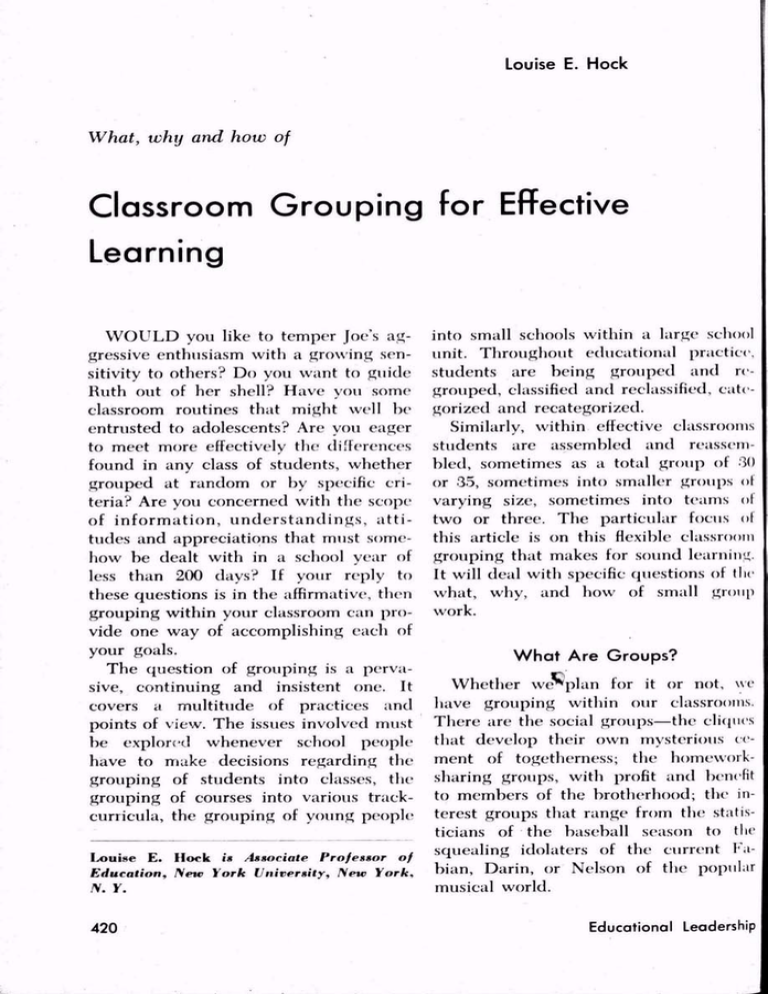
Louise E. Hock
What, why and how of
Classroom Grouping for Effective
Learning
WOULD you like to temper Joe's ag
gressive enthusiasm with a growing sen
sitivity to others? Do you want to guide
Ruth out of her shell? Have you some
classroom routines that might well be
entrusted to adolescents? Are you eager
to meet more effectively the differences
found in any class of students, whether
grouped at random or by specific cri
teria? Are you concerned with the scope
of information, understandings, atti
tudes and appreciations that must some
how be dealt with in a school year of
less than 200 days? If your reply to
these questions is in the affirmative, then
grouping within your classroom can pro
vide one way of accomplishing each of
your goals.
The question of grouping is a perva
sive, continuing and insistent one. It
covers a multitude of practices and
points of view. The issues involved must
be explored whenever school people
have to make decisions regarding the
grouping of students into classes, the
grouping of courses into various trackcurricula, the grouping of young people
Louise E. Hock i* Associate Professor of
Education, New York University, l\ew York,
!V. Y.
420
into small schools within a large school
unit. Throughout educational practice,
students are being grouped and re
grouped, classified and reclassified, cate
gorized and recategorized.
Similarly, within effective classrooms
students are assembled and reassem
bled, sometimes as a total group of 30
or 35, sometimes into smaller groups of
varying size, sometimes into teams of
two or three. The particular focus of
this article is on this flexible classroom
grouping that makes for sound learning.
It will deal with specific questions of tlie
what, why, and how of small group
\vork.
What Are Groups?
rv
Whether we*plan for it or not, \ve
have grouping within our classrooms.
There are the social groups the cliques
that develop their own mysterious ce
ment of togetherness; the homeworksharing groups, with profit and benefit
to members of the brotherhood; the in
terest groups that range from the statis
ticians of the baseball season to the
squealing idolaters of the current Fa
bian, Darin, or Nelson of the popular
musical world.
Educational Leadership
Our adolescents turn to each other
For purposes of their own for social
warmth, practical help, identification,
assurance and reassurance in their world
>f change and growth. Youngsters group
naturally and we should use this pro
pensity to group living, no matter how
ephemeral and vacillating it may seem
at times. When we utilize this need of
human beings to be drawn to other hu
man beings, when we channel this need
in worthwhile educational directions,
we are capitalizing on one more of our
reservoir of sound resources in an effort
to improve the learning situation.
What are these educational groups we
t-an form and should form? There is the
"buzz" group of short duration and im
mediate purpose. With these quickly
formed groups of five or six, we can
provide opportunities for rapid sharing
of homework assignments, for exchange
of ideas and experiences, for formula
tion of problems and questions, for dis
cussion of controversy and differences.
Then there are the "job" groups, of
short or long term duration. Some stu
dents can constitute a materials com
mittee, whose function is to locate and
arrange for the use of appropriate
recordings, films, tapes, filmstrips, and
other instructional materials pertinent
to a particular unit of study. Or there
might be a bulletin board committee,
charged with the responsibility of main
taining attractive and informative dis
plays of pictures, articles, original mate
rial, relevant to any subject of study or
interest to a given class. Current events
committees are another source of study
and information for many classes in tl>e
social studies, science, and language arts
fields.
A third type of grouping is repre
sented by "work-study" committees, or
ganized to facilitate deeper and broader
April 1 961
exploration of various aspects of a prob
lem or unit. These committees become
involved with all the processes of
sound research planning, investigating,
organizing, sharing, solving, and sum
marizing. A science class may have sev
eral committees researching the many
peace-time uses of nuclear energy. Such
a class will have a broader grasp of the
role of nuclear energy in our daily lives
and deeper insights into issues and im
plications than will a class that, with one
eye and one voice, skims the surface
of the brief account found in the stand
ard text.
Buzz groups, job groups, study-work
committees these are only a few of the
kinds and varieties of classroom group
ing. They can all play an important part
in facilitating learning and should be
utilized at appropriate times and for ap
propriate purposes.
Why Should We Group?
The reasons for small group work
within our classes are obvious and valid,
but they cannot be reiterated often
enough in this age of conformity.
First of all, we group in order to pro
vide for the vast differences that exist
among any aggregation of individuals.
The great varieties of interests and pur
poses, the wide range of talents and
skills, the important differences in abil
ity and potential, in speed, depth and
nature of comprehension all these dis
tinctions necessitate the use of many
varied materials and resources as well
as classroom procedures that provide
opportunities for each student to move
as rapidly as possible in reaching his
own potential. And these great differ
ences exist, regardless of any effort to
implement ability grouping. For while
students can be assigned to classes on
421
the basis of similar I.Q. scores and read
ing levels, all the other kinds of dif
ferences cited here are present and
defeat any effort at "homogeneous"
teaching, and rightly so.
We can no longer afford the luxury
of such homogeneous teaching, wherein
30 students read the same book, answer
the same questions, listen to the same
words as continuing standard fare dur
ing the school year. In fact, the results
of such standardized teaching lead us
to a second reason for using groups
within our classrooms that of promot
ing more effective learning. We have
much evidence to support the thesis
that small group work, when appropri
ate, can result in better learning. For
example, we know that people tend to
learn better that which has meaning and
purpose for them; that learning is more
effective when the learner is actively
involved in the learning process; that
the total "power" in a group is often
greater than the sum of power found
in the individuals involved. Were we to
keep only these three guiding principles
in mind, we would see how a judicious
use of committee and small group work
can improve the quality and quantity of
learning.
A third reason for grouping within
our classrooms can be stated simply
to vary our teaching-learning proce
dures. Variety in the learning situation
is essential if we are to match method
with purpose, procedure with content,
approach with maturity level and stu
dent needs. The whole concept of
method is based upon the appropriate
ness of any given procedure, technique,
approach to the relevant factors in
volved nature of the learners, nature
of any given content, nature of purposes
and goals, to name the major considera
tions. Therefore, any sound theory of
422
methodology involves the use of varied
teaching procedures, which in turn in
clude the use of small group work.
Another reason for variety in the1
learning situation lies in the nature of
adolescents, who in their early devel
opment have relatively short attention
span and need frequent and relevant
change of pace. In addition, they need
opportunities for productive release of
energy, opportunities that can be found
in their own involvement in as many
aspects of the learning process as possi
ble. The stereotype of the traditional
classroom teacher in front of the room
directing a recitation with expected con
formity of behavior, response and atten
tion from class members during the en
tire period offers little opportunity for
release of pent-up energy and necessary
muscular and mental activity so typical
of the adolescent age.
Perhaps the most significant reason of
all for using small group work is that
by so doing we are helping to achieve
one of the most important goals of edu
cation the development of an individ
ual capable of living and working within
the society of men. One of the most in
sistent needs of modern times is the
need of men to learn to live together in
some semblance of peace and order.
Mankind has not yet acquired the knowhow for such global existence, although
efforts have been made since the dawn
of time. It would be fantastic and tragic
to believe that individuals are born with
the talent to live with others. Rather this
is a learned skill, an acquired art; and
it is time that the school must recognize
its responsibility in teaching the funda
mentals of good human relationships.
In many instances we group in the
classroom in terms of commonality
of interests, skills, talents, ability. At
other times grouping should be based
Educational Leadership
upon differences, involving varied back
grounds, viewpoints, personalities.
These two kinds of grouping play an
important role in achieving the aims of
the educative process.
How Can We Group?
A usual form of small group work
based on commonality among students
is that of small interest groups. Regard
less of the nature of the group workstudy, buzz, or job committee then1
are many times when students can be
grouped on the basis of a common in
terest. The interest might take the form
of decorating for a class party, explor
ing the relationship of mathematics to
architecture, investigating statistics con
cerning mental illness in urban com
munities, preparing a bulletin board
on Presidential inaugurations. Whatever
the problem, topic or task, it is a com
mon interest in it that ties the students
in that particular committee or group
together. Together they can plan, inves
tigate, share, solve, accomplish in the
pursuit of the specific goals or tasks
facing them.
Similarly, a skill or talent brings some
students together for working purposes.
In an English class study of newspapers
and their role in contemporary society,
students might decide to prepare a
newspaper of their own; or a history
class might want to develop a news
paper as it might have appeared in the
time of the Revolutionary War. In
either case there will be some students
who can type who will assume the re
sponsibility for that aspect of produc
tion; there will be other talented young
sters who will take charge of the art
work; while still others, based upon in
terest, will work on feature articles, ed
itorials, advertisements, and the like. Not
April 1961
only is this a practical demonstration of
essential division of labor but also a
working model of the variety of talents
and skills and interests needed in produc
ing an essential feature of our everyday
life.
In a different way, grouping on the
basis of commonality can be utilized in
an English class to help with reading
skills or in a mathematics class to guide
comprehension of various processes.
There are many times when teachers of
these subjects should meet with small
groups of students who have similar
problems in increasing their reading
rate or understanding a certain gram
matical principle or penetrating the mys
teries of prime factoring. How wasteful
of pupil man-hours is the teacher who
"spends" the time of an entire class to
drill and review a process, skill or con
cept that is understood by a large num
ber, even a majority of the class.
We must not, though, overlook the
many occasions when we should be per
mitting students to group on behalf of
differences rather than similarities. For
example, where exchange of opinion is
desirable, we can provide for buzz
group sessions. During these sessions,
adolescents share with each other re
actions to books they have been reading
or the themes, essays, or compositions
that are a part of every writing pro
gram. Not only should students have the
benefit of the resulting wider acquaint
ance with literature and their own crea
tive writing, but this procedure also has
the merit of saving time. Thirty book
reports, given singly, may not only pro
mote boredom but may take precious
class time that can otherwise be put to
more effective use.
Similarly, when critical and contro
versial issues are under discussion and
study, the therapy involved in letting
423
students exchange ideas, beliefs, opin
ions and even prejudices in quick buzz
groups may be recommended. Young
people must have opportunities to dis
cover how other people their own
classmates think and feel about many
matters, varying from "going steady" to
"advantages and disadvantages of for
eign aid proposals." In addition, they are
gaining valuable experience in a muchneeded art that of communication for
understanding.
Guides for Effective Grouping
For those who would engage in class
room grouping practices there are some
guidelines that are important if maxi
mum values are to be gained. Only a
few can be mentioned here.
First of all, it is essential to remem
ber that grouping procedures should
be used only when they are appropri
ate to the task at hand, the goals to''be
achieved, the nature of the content in
volved. Also they must be handled in
ways appropriate to the maturity level
of the students and to their experience
with such procedures. Certainly a class
that has never experienced small group
work should not be plunged into diffi
cult committee study without careful
guidance and realistic expectations.
Related to this caution is another
guideline: a constant recognition that
group living and group processes are
learned skills. As such they are subject
to the same helpful guidance and prac
tice and evaluation that are involved in
all learning, whether it be ideas, infor
mation, attitudes, skills or appreciations.
Patience and imagination on the part of
the teacher, along with firm understand
ing of human behavior, individual and
social, are essential for effective teach
ing of group processes.
424
In this regard it is wise to bear in
mind the maxim, make haste slowly.
The teacher must be sure that students
understand what it is that they are to
do and that they have clear-cut proce
dures for moving ahead. When false
starts are made, teacher and class must
re-examine their plans, modify proce
dures where necessary, try again and
again and again.
In the final analysis the role of the
teacher is, of course, crucial. The
teacher who assumes that, once a class
is organized into groups or commit
tees, students should automatically
make progress without delays, difficul
ties or differences, is unrealistic and
naive, if riot incompetent.
On the other hand, the teacher who
sees the skills of group living and work
ing as similar to skills in communicat
ing and computing and critical think
ing will devote the same patience and
understanding and planning normally
given to these latter learnings. He will
meet with each work committee as often
and as long as necessary for its effective
functioning. He will see that appropri
ate and sufficient resource and research
materials are available. He will move
rapidly from buzz group to buzz group,
catching the essence of each in both
content and process as he roams. He
will develop with his students ways of
recording and reporting progress, indi
vidual and group. He will note per
sonality clashes and individual problems
and provide suitable guidance. He will
expect of his students the best of which
they are capable, knowing that few per
sons ever match grasp with reach.
In short, the teacher who uses groups
and committees to further the education
of his charges is placing the responsi
bility for learning where it primarily be
longs in the hands of the students.
Educational Leadership
Copyright © 1961 by the Association for Supervision and Curriculum
Development. All rights reserved.




